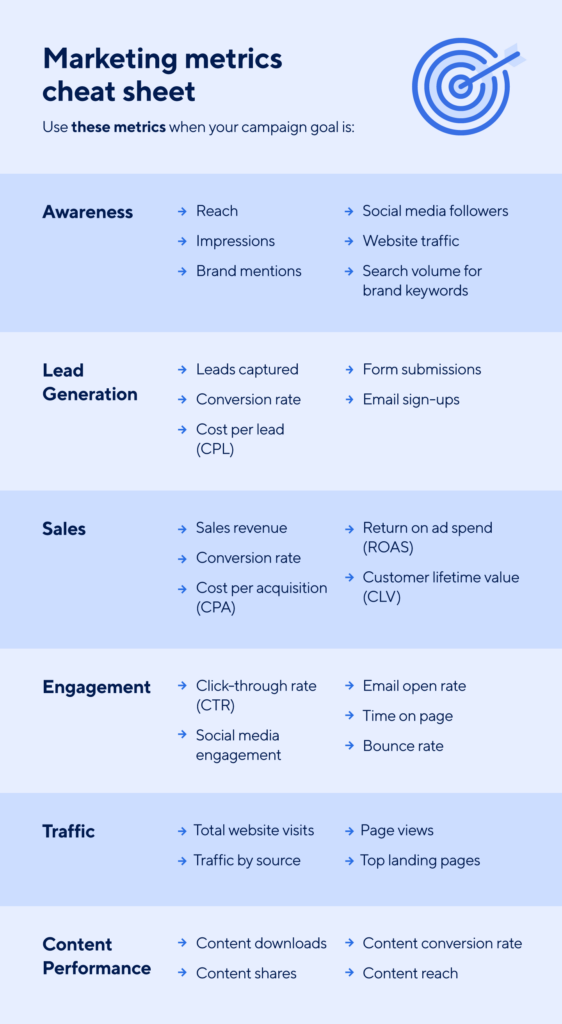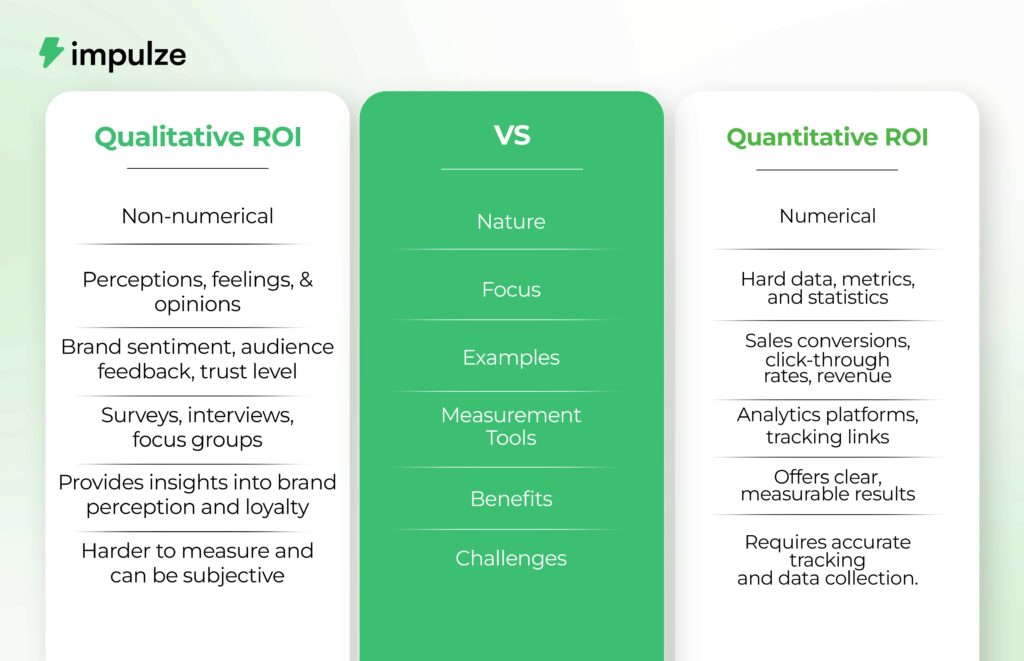The voice of consumers is driven by creator campaigns. Brand awareness, engagement, conversions are pivotal in this attempt at capturing and measuring these voices. As brands invest more in creator partnerships, measuring the success of these campaigns is crucial to ensuring a strong return on investment (ROI) and fine-tuning future efforts.
This guide will walk you through the key metrics and strategies for effectively measuring creator campaigns. It will help you optimize performance and maximize impact.
Key Metrics for Measuring Creator Campaigns

If you want to know what’s working for your brand and what isn’t, measuring creator campaigns is a no-brainer. This includes tracking a range of metrics that provide insights into audience engagement, reach, and the campaign’s overall impact. According to Influencer Marketing Hub, nearly 80% of brands track sales from influencer campaigns. If you want to be one of them below are the essential metrics you should focus on:
Engagement Metrics
Engagement is one of the most crucial indicators of how well a creator’s content resonates with their audience and ultimately yours. It reflects the level of interaction with the content, which can directly influence conversions and brand awareness.
- Likes, Shares, Comments: These metrics reflect how much the audience is engaging with the content. Higher numbers indicate that the content is resonating, but deeper engagement like comments can reveal how strongly the audience is connecting with the message.
- Save Rates and Direct Messages: On platforms like Instagram, save rates show that the content is valuable enough to revisit later. Direct messages also indicate a deeper level of engagement, as viewers are compelled to initiate a conversation or ask questions.
- Engagement Rate Formula: The engagement rate provides a normalized measure of interactions in relation to the creator’s audience size. It is calculated by the formula:
Engagement Rate = (Total Engagements / Total Followers) × 100
This gives you a percentage that helps compare performance across creators, regardless of their follower count.
Reach and Impressions
Reach and impressions help gauge the visibility of your content. While they may seem similar, they offer distinct insights.
- Reach refers to the number of unique users who have seen the content. This shows how far the content has spread.
- Impressions measure the total number of times the content was viewed, even if it was seen multiple times by the same user.
- Tracking Across Platforms: Each platform offers its own analytics for reach and impressions (e.g., Instagram Insights, YouTube Analytics, Facebook Insights), and tracking these across multiple platforms is essential for understanding the full scope of a creator’s influence.
Conversion Metrics
Conversions are the ultimate measure of how well a campaign is performing in driving desired actions, whether that’s sales, sign-ups, or downloads.
- Click-Through Rates (CTR): CTR measures the percentage of people who clicked on a link within the creator’s content. It’s calculated as:
CTR = (Clicks / Impressions) × 100
A high CTR indicates that the content is compelling enough to encourage action.
- Conversion Rates: Once users click on the link, conversion rates track how many of them completed the desired action, such as making a purchase or signing up for a newsletter. This metric shows how effectively the content is driving meaningful results.
- Tracking Affiliate Links, Promo Codes, and UTM Parameters: These tools allow you to trace conversions directly back to the creator’s content, offering clear insight into how much revenue or engagement was generated by their efforts.
Audience Growth
Growth metrics help you measure how well the creator’s content is expanding your audience and increasing your brand’s reach.
- Increase in Followers, Subscribers, or Email Sign-Ups: Successful campaigns can lead to growth in the creator’s audience or direct growth in your brand’s own followers or subscribers. Tracking this helps determine if the campaign is fostering brand loyalty.
- Tracking New Audience Demographics: Beyond just numbers, it’s essential to look at who is following your brand as a result of the campaign. Are you reaching a new segment or expanding into a different demographic? Analytics tools across platforms can help you monitor this.
An article you might like to read: Boosting Sales with Authentic Content
Sentiment Analysis
While engagement and growth are essential, understanding how the audience feels about your brand is equally important. Sentiment analysis provides insight into whether the audience’s reaction to the campaign is positive, neutral, or negative.
Pay attention to the tone of the comments, mentions, and conversations surrounding your brand. Are people excited, skeptical, or indifferent? This qualitative data is vital for understanding the true impact of your campaign.
AI tools or manual tracking through content analysis can provide deeper insights, especially when analyzing specific campaign themes or messages.
Qualitative vs. Quantitative Data

When measuring the success of creator campaigns, both quantitative and qualitative data play crucial roles. While numbers provide a clear, data-driven view of performance, qualitative insights offer a deeper understanding of the nuances in audience reactions and brand alignment.
Understanding the Importance of Qualitative Feedback
Quantitative data—such as likes, shares, impressions, and conversions—gives you concrete metrics to track campaign performance. However, qualitative feedback from both creators and their audiences can reveal insights that go beyond the numbers.
What are people saying in the comments? Are they genuinely excited about the product or service? Do their responses indicate trust and interest, or is there skepticism?
The creator’s experience working with your brand is also invaluable. Their perspective on how well your product or service fits with their personal brand, the ease of collaboration, and feedback on the campaign messaging can help refine future partnerships.
Balancing Quantitative Data with Qualitative Insights
To get a holistic view of your campaign’s performance, it’s important to strike a balance between quantitative data and qualitative insights. Here’s how to do that effectively:
- Brand Alignment: Assess whether the creator’s content aligns with your brand’s values and mission. This is not something that can always be measured by data, but rather by analyzing the consistency of messaging and tone. Does the creator’s content reflect your brand identity in a way that feels authentic and resonant with their audience? A creator’s strong engagement metrics might mean little if the content feels out of sync with your brand.
- Narrative Consistency: Look at how the creator tells the story of your brand or product. Is it consistent with the broader narrative you’re trying to build? Qualitative insights here can help you gauge whether the storytelling is clear, compelling, and aligned with your brand’s goals. Audience feedback through comments and reactions can provide clues on whether the message is getting through effectively.
In essence, quantitative data gives you the “what” of campaign performance—what happened in terms of reach, engagement, and conversions. Qualitative insights provide the “why”—why the audience responded the way they did, why certain content resonated, and why brand alignment mattered in the campaign’s success. By analyzing both, you can create a well-rounded evaluation of your creator campaigns.
ROI and Cost per Acquisition (CPA) Calculations
Ultimately the marketing goal is to get more business. For this, measuring the return on investment (ROI) and calculating the cost per acquisition (CPA) are two of the most critical steps in evaluating the financial success of your creator campaigns. These metrics help ensure that the resources spent on partnerships with creators generate tangible results that contribute to your business goals.
How to Measure ROI for Creator Campaigns
ROI provides a clear picture of the profitability of your creator campaign, comparing the revenue generated against the investment made. It’s a crucial metric that helps brands understand if the campaign’s performance justifies its costs.
To calculate ROI for a creator campaign, use the following formula:
ROI = (Revenue Generated – Cost of Campaign) / Cost of Campaign × 100
Here’s how to approach this calculation:
Revenue Generated: This includes all the sales, leads, or other forms of revenue directly attributable to the creator’s content. This can be tracked using methods like UTM codes, affiliate links, or unique promo codes provided to the creator.
Cost of Campaign: This encompasses all expenses related to the creator campaign, including creator fees, production costs, paid ad boosts, and any other resources spent on the partnership.
For example, if a campaign cost $10,000 and it generated $30,000 in sales, the ROI would be:
(30,000 – 10,000) / 10,000 × 100 = 200%
A 200% ROI means that for every dollar spent, the campaign returned two dollars in revenue.
Calculating Cost Per Acquisition (CPA)
Cost per acquisition (CPA) is another essential metric that measures how much it costs your brand to acquire one customer or lead through the campaign. It’s particularly useful when your goal is focused on direct sales, sign-ups, or another specific conversion action.
The formula for calculating CPA is:
CPA = Total Cost of Campaign / Number of Conversions
Here’s how to break this down:
Total Cost of Campaign: As with ROI, this includes all expenses related to the creator campaign.
Number of Conversions: This refers to the total number of desired actions (e.g., purchases, sign-ups, downloads) achieved through the campaign.
For instance, if a creator campaign costs $5,000 and results in 100 conversions, the CPA would be:
5,000 / 100 = $50 per acquisition.
Understanding How CPA Varies by Campaign Goal
It’s important to recognize that CPA can vary depending on the goals of your campaign. Here’s how different campaign objectives impact CPA:
- Sales and Direct Conversions: When the goal is direct sales, CPA can be easily calculated by tracking how many purchases resulted from the campaign. In this case, a lower CPA indicates a more cost-efficient campaign.
- Lead Generation: For campaigns focused on lead generation (such as email sign-ups or app downloads), the CPA is calculated based on the number of leads rather than sales. Keep in mind that while the CPA for lead generation may be lower than for sales, these leads still need nurturing to eventually convert into paying customers.
- Brand Awareness: Campaigns focused on brand awareness are harder to measure directly in terms of CPA since their goal isn’t immediate conversions. In these cases, brands may rely more heavily on metrics like reach, impressions, and engagement, using CPA as a longer-term measure of acquisition from follow-up campaigns.
By calculating both ROI and CPA, you can get a clear understanding of your campaign’s financial efficiency and success. Together, these metrics help you determine whether the resources invested in creator partnerships are yielding profitable outcomes.
An article you might like to read: 3 Truths and 1 Lie about Influencer Marketing for eCommerce brands
Attribution Models
Attribution models are essential for understanding how different touchpoints in a customer’s journey contribute to conversions. In creator campaigns, consumers often interact with a brand multiple times before making a purchase or taking the desired action. Attribution models help determine how much credit each interaction should receive, providing deeper insights into the effectiveness of each campaign.
The Concept of Attribution Models in Creator Campaigns
In creator campaigns, attribution models track the impact of various content pieces and interactions that drive conversions. Below are the key types of attribution models commonly used:
First-Click Attribution
This model assigns all credit for the conversion to the first interaction a customer had with your brand. For example, if a consumer first discovers your product through a creator’s Instagram post but later purchases through a different channel, the Instagram post would receive all the credit. First-click attribution is useful when you want to identify the creators or channels that are generating initial awareness and traffic.
Last-Click Attribution
In contrast, last-click attribution assigns all credit to the final interaction before the conversion. If a consumer first discovers your product through a creator’s post but clicks on a retargeting ad to make a purchase, the ad gets 100% of the credit. This model is widely used but can overlook the influence of earlier interactions in the customer journey.
Multi-Touch Attribution
This model spreads credit across all interactions in the customer journey, giving you a more complete view of how various touchpoints (e.g., multiple creator posts, ads, and emails) contributed to the final conversion. Multi-touch attribution can assign equal credit to each touchpoint or weigh them differently depending on their significance in the journey. This model is especially useful for longer sales cycles, where consumers interact with multiple content pieces before converting.
By understanding which model best fits your campaign goals, you can better allocate budget and resources to the creators and channels that drive the most impact.
Conclusion
If you measure a creator campaign, you not only understand how well your brand is performing, but also gather a ton of learning for the campaigns that follow. By tracking key metrics, leveraging both quantitative and qualitative data, and utilizing attribution models, brands can also gain valuable insights into what drives success. Now is the time for you to implement robust measurement frameworks that enable data-driven decision-making. This ensures long-term growth and success in campaigns.



















